CT-based radiomics deep learning signatures for noninvasive prediction of early recurrence after radical surgery in locally advanced colorectal cancer: A multicenter study
IF 2.9
2区 医学
Q2 ONCOLOGY
引用次数: 0
Abstract
Objective
Preoperative identification of high-risk locally advanced colorectal cancer (LACRC) patients is vital for optimizing treatment and minimizing toxicity. This study aims to develop and validate a combined model of CT-based images and clinical laboratory parameters to noninvasively predict postoperative early recurrence (ER) in LACRC patients.
Methods
A retrospective cohort of 560 pathologically confirmed LACRC patients collected from three centers between July 2018 and March 2022 and the Gene Expression Omnibus (GEO) dataset was analyzed. We extracted radiomics and deep learning signatures (RDs) using eight machine learning techniques, integrated them with clinical-laboratory parameters to construct a preoperative combined model, and validated it in two external datasets. Its predictive performance was compared with postoperative pathological and TNM staging models. Kaplan-Meier analysis was used to evaluate preoperative risk stratification, and molecular correlations with ER were explored using GEO RNA-sequencing data.
Results
The model included five independent prognostic factors: RDs, lymphocyte-to-monocyte ratio, neutrophil-to-lymphocyte ratio, lymphocyte-Albumin, and prognostic nutritional index. It outperformed pathological and TNM models in two external datasets (AUC for test set 1:0.865 vs. 0.766, 0.665; AUC for test set 2: 0.848 vs. 0.754, 0.694). Preoperative risk stratification identified significantly better disease-free survival in low-risk vs. high-risk patients across all subgroups (p < 0.01). High enrichment scores were associated with upregulated tumor proliferation pathways (epithelial-mesenchymal transition [EMT] and inflammatory response pathways) and altered immune cell infiltration patterns in the tumor microenvironment.
Conclusion
The preoperative model enables treatment strategy optimization and reduces unnecessary drug toxicity by noninvasively predicting ER in LACRC.
基于ct的放射组学深度学习特征无创预测局部晚期结直肠癌根治性手术后早期复发:一项多中心研究
目的术前对高危局部晚期结直肠癌(LACRC)患者进行识别是优化治疗和降低毒性的关键。本研究旨在建立并验证基于ct图像和临床实验室参数的联合模型,以无创预测LACRC患者术后早期复发(ER)。方法回顾性分析2018年7月至2022年3月来自三个中心的560例病理证实的LACRC患者,并分析基因表达综合(GEO)数据集。我们使用八种机器学习技术提取放射组学和深度学习特征(rd),将其与临床-实验室参数集成以构建术前联合模型,并在两个外部数据集中验证。比较其术后病理和TNM分期模型的预测性能。采用Kaplan-Meier分析评估术前风险分层,并利用GEO rna测序数据探讨与ER的分子相关性。结果该模型包括5个独立的预后因素:rd、淋巴细胞/单核细胞比、中性粒细胞/淋巴细胞比、淋巴细胞-白蛋白和预后营养指数。它在两个外部数据集上优于病理模型和TNM模型(测试集的AUC为:0.865比0.766,0.665;测试集2的AUC为:0.848比0.754,0.694)。术前风险分层发现,在所有亚组中,低风险患者的无病生存率明显高于高风险患者(p < 0.01)。高富集分数与肿瘤增殖途径(上皮-间质转化[EMT]和炎症反应途径)的上调以及肿瘤微环境中免疫细胞浸润模式的改变有关。结论术前模型通过无创预测LACRC的ER,可以优化治疗策略,减少不必要的药物毒性。
本文章由计算机程序翻译,如有差异,请以英文原文为准。
求助全文
约1分钟内获得全文
求助全文
来源期刊

Ejso
医学-外科
CiteScore
6.40
自引率
2.60%
发文量
1148
审稿时长
41 days
期刊介绍:
JSO - European Journal of Surgical Oncology ("the Journal of Cancer Surgery") is the Official Journal of the European Society of Surgical Oncology and BASO ~ the Association for Cancer Surgery.
The EJSO aims to advance surgical oncology research and practice through the publication of original research articles, review articles, editorials, debates and correspondence.
 求助内容:
求助内容: 应助结果提醒方式:
应助结果提醒方式:


